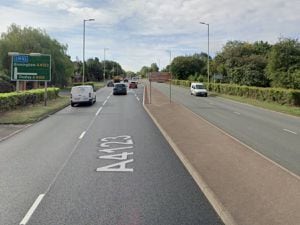Husband died six weeks after being hit by bike in 'tragic' Black Country crash
A Black Country man was in the middle of a carriageway when he was hit by a motorcycle and fatally injured, an inquest heard.

Lee Flukes, 41, was crossing the A461 Horseley Heath with his 39-year-old wife, Lindsay when they were struck by the bike at around 9.30pm on September 26, 2019.
Mr Flukes, of Watt Road, Tipton, was rushed to Birmingham’s Queen Elizabeth Hospital with internal injuries and fractures including a broken pelvis and died six weeks later on November 9.
On Wednesday Black Country Coroner’s Court heard that Luke Tranter-Logan was riding his father’s Honda motorcycle home from Merry Hill Shopping Centre when the collision occurred.
He was riding in the centre of the lane and the motorcycle’s lights were on.
“I did not realise there was someone in the carriageway until they were in front of my bike,” said Mr Tranter-Logan, 29.
“It looked like two black figures to me - I knew straight away it was a pedestrian.”
“Were you paying attention?” asked the coroner Joanne Lees.
“Yes, I was paying full attention,” Mr Tranter-Logan replied.
“I looked ahead to the traffic lights to see if they were green or red so I could react accordingly.”
Mr Tranter-Logan said he remembers something wrapping around the bike - identified as a tool box belonging to Mr Flukes - and he pulled into the entrance of the Lidl store on the A461, got off and lay on the floor.
“I tried to push myself up but could not,” said Mr Tranter-Logan who had sustained a fractured neck.
“I knew the lights at the pedestrian crossing were green so I could not understand how I hit somebody.
“I just did not see them in front of me.”
The court heard that Mr Tranter-Logan was wearing goggles that the manufacturer recommended should not be worn at night, something he said he was not aware of.
It was also stated that he had been riding at an average speed of 39 miles per hour prior to the collision when the speed limit on that stretch of road is 30 mph.
Senior Investigating Officer Detective Sergeant Paul Hughes said Mrs Flukes was not interviewed following the collision but that there had been contact with her through the Family Liaison Officer.
“I put her welfare first in not putting her through a formal interview,” he said.
“The investigation was based on CCTV evidence. Unfortunately it provided a before and after.
“The impact was in a blind spot - there was not CCTV of the collision.”
Det Sgt Hughes referred to a statement from Surjit Bhogal, who was driving a Toyota Yaris in the same lane as Mr Tranter-Logan and had both pulled away from traffic lights back along the A461.
“The motorbike drove off once the lights changed to green,” she said.
“I pulled away but the bike made quite a bit of ground on me.
“I saw a shadow in the central reservation of the road and started to slow when I heard the bang.”
Detective Constable Stuart McNeil, who arrived at the scene around 90 minutes after the collision, wrote a report of the subsequent investigation.
He told the court that at the time the weather was “dry, clear, there was no fog, mist or precipitation” and the road was dry and had no sign of contaminants”.
He explained that a reconstruction took place later which showed that the position where Mr and Mrs Flukes crossed is between two beams of street lighting.
“Bearing in mind the dark clothing they were wearing, the lighting and the approaching vehicle providing glare from the lights, I found it hard to identify anyone in the road,” said DC McNeil.
“I struggled to discern anyone until one second before impact - 17.5 meters away - from the perspective of the motorcyclist.”
The coroner Joanne Lees said: “We know that the speed of Mr Tranter-Logan was an average of 39 miles per hour.
“We know the speed limit on the road was 30 miles per hour.
“If Mr Tranter-Logan had been travelling at the speed limit would it have changed the visibility of persons in the carriageway?
“In my opinion no,” Det Con McNeil replied.
The coroner said there were no witnesses who described seeing pedestrians in the carriageway at any point.
She added that although Mr Tranter-Logan was travelling at 39 miles per hour speed was not a contributory factor in the collision and neither were his goggles.
“I am satisfied that the position of the bike was central, it did not deviate, and it is the case that Mr Flukes entered into the lane that Mr Tranter-Logan was travelling in,” she said.
“Mr Flukes’ position was obscured for a number of reasons - the crossing between two pools of light, the colour of clothing worn by Mr Flukes and, although there were streetlights, it was dark.
“On the evidence it is unlikely Mr Tranter-Logan saw Mr Flukes in the carriageway before the collision to the extent that he would have been able to stop and prevent it.
“This is a unique set of circumstances that occurred primarily because of the position of the pedestrians in the carriageway rather than the absence of road safety measures in the vicinity.
“There are already uncontrolled and controlled crossings relatively near.”
After concluding Mr Flukes’ death was due to a road traffic collision the coroner said to his widow: “There is nothing I can say that will take away your pain. It is a tragic set of circumstances.
“There is never going to be an inquest that answers all the questions.
“I wish you all the best moving forward.”





